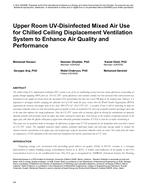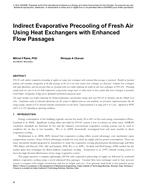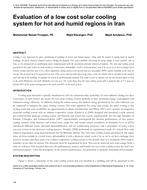-
-
Available Formats
- Options
- Availability
- Priced From ( in USD )
-
Available Formats
-
- Immediate download
-
$16.00Members pay $12.00
- Add to Cart
Customers Who Bought This Also Bought
-

First International Conference on Energy and Indoor Envir...
Priced From $47.00 -

Upper Room UV-Disinfected Mixed Air Use for Chilled Ceili...
Priced From $16.00 -

Indirect Evaporative Precooling of Fresh Air Using Heat E...
Priced From $16.00 -

Evaluation of a Low Cost Solar Cooling System for Hot and...
Priced From $16.00
About This Item
Full Description
The testing and rating procedure for seasonal energy efficiency ratio (SEER) established by U.S. Department of Energy provides a performance benchmark for heat pumps and air conditioners. However, past research has indicated that SEER as a universal index is not an adequate metric for regional performance. In addition, based on field measurements, the SEER hardly reflects the installation and operational conditions in real houses because of its low external static pressure and default fan power. The objective of this study was to evaluate the impact of high ambient temperature on the performance of a typical 5 ton, R410a air conditioner. Since the hottest outdoor temperature used in the current test procedure for EER and capacity measurement is 95°F (35°C), no information is available to characterize the performance at extreme conditions through standard rating tests. Laboratory tests were conducted at outdoor temperatures of 95°F and 115°F along with indoor wet-bulb temperatures of 63°F and 67°F, with a fixed indoor dry-bulb temperature of 80°F. The performance of the A/C unit was quantified by measuring capacity, power, energy efficiency ratio (EER) and sensible heat ratio (SHR). The results showed that a 20°F increase in outdoor ambient temperature resulted in a 25% rise in compressor power consumption, a more than 13% decrease in total capacity and finally a 28% decline in EER and sensible EER. Furthermore, when the indoor wet-bulb temperature was reduced from 67°F to 63°F for 95°F and 115°F outdoor temperature settings, then the total capacity declined about 6% and 2%, the EER was reduced 5.5% and 1%, and the SHR increased 25% and 25%, respectively. The results generated in this study can be used to investigate the cooling performance and the energy consumption of air conditioners in regions with extended periods of extreme hot ambient conditions.





